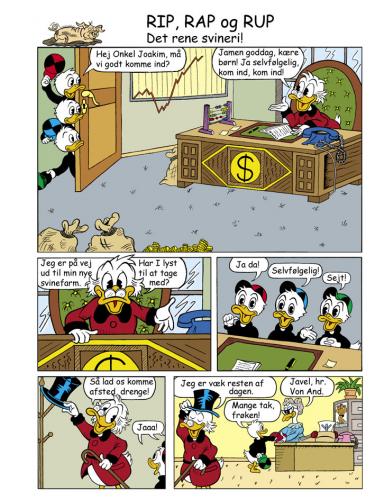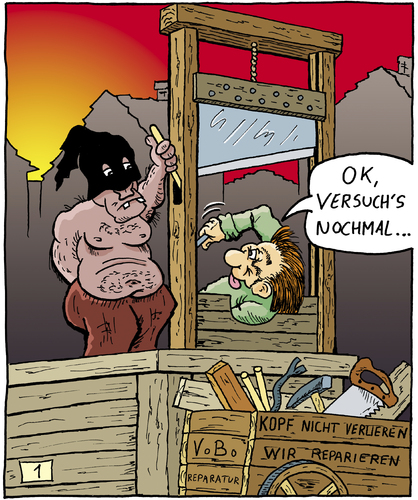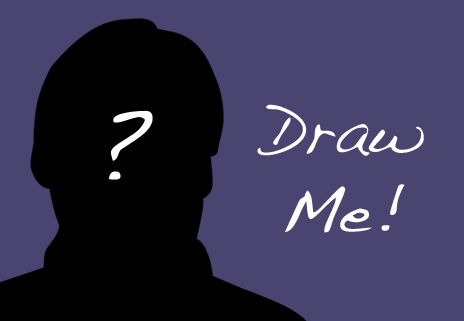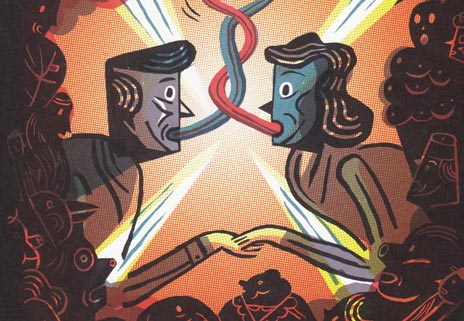I met Niels von Boldvig, aka Vo Bo in the jury for the toonpool.com Election Cartoon Contest. When I learned that he worked for the Walt Disney Company as a freelance colorist, I got pretty excited: As a kid, I spent loads of money and time on everything Duckburg-related and today I feel nostalgic when I see the works of Carl Barks and Don Rosa. Or Romano Scarpa and Giovan Battista Carpi. In fact, any Duck will do. Apart from that, questions about colorizing comics and cartoons pop up regularly on internet forums, so I decided others might be interested as well to hear from a professional.
Niels, can you tell me how you ended up as a colorist for Disney?
Well, pull out a chair and sit down, because it is a long story. It all began when I quit my job at a large refrigeration company to stay at home for some time and take care of the household and our two children – they were 9 and 5 then. At that time, I started drawing again and I discovered how to do the coloring on computer. Through the internet I got in contact with other amateur artists around the world and from time to time I did a little coloring for some of them.
My daughter also likes to draw and she is a big fan of Disney. She always asked me, why I didn’t try to do something for them? She kept nagging and pushing me, and finally, back in 2004, I took the chance and wrote a letter to Egmont in Copenhagen, which is the “Disney HQ” in Europe. I told them I knew they probably received many letters every day from people asking about how to “join the team”, but I had promised my daughter to ask, because she was a big fan and would love to see her dad working with Disney. I attached a few samples of my coloring work and thought, well, now I have done what my daughter told me and that’s that.
But they did answer?
Yes, a few days later Egmont called me and invited my daughter and me over for lunch and a chat. They would send me a 6-page Grandma Duck story they would like me to color as a test in advance. A couple of days later we took the train from Aarhus to Copenhagen and saw “the holy halls” of Egmont. At that time my daughter was 15 years old, but her eyes were shining like the eyes of a little girl at Christmas time and so were mine.
What did they tell you?
They told me that they do receive several letters every day, but my story and samples had made them very curious, so they simply had to see who I was. And regarding the test, it was the first time they had ever seen a “first attempt” with so few errors and the way I was able to “guide” the readers down through the pages by the use of my coloring was excellent!
I thought to myself: “Relax, it’s just a comic”, but of course now I know how important the coloring of a cartoon and comic can be. Anyway, after a very pleasant meeting and a nice lunch on the roof of the building with a wonderful view over Copenhagen, we took the train back home, very happy about having seen the place controlling every move of Donald Duck and the Disney Family in Europe. Then came the call: “We decided that we should like very much, if you could take over the coloring of the Winnie the Pooh magazine published in Norway, Sweden and Finland. Would you be interested?”. It took me about two seconds to decide.
What kinds of comic books have you colored so far?
I have colored about 200 Winnie the Pooh stories and maybe 20 to 30 Donald Duck, Mickey Mouse and Goofy stories. I actually once re-colored a Carl Barks story, which I guess is pretty cool.
So, what is your job as a colorist like? How many pages do you finish each day?
I work from home, as a freelance “artist”. All file exchange is done through a ftp-server where I pick up the black & white pages and drop them of again when the coloring is done. The amount of pages I can finish in one day depends on the quality of the line art and the complexity of the drawings. I once did 11 pages in one day, but 2-3 pages is average for this kind of work. After my coloring is done there is a quality control by Egmont. You can of course miss an ear, a finger or a little flower, but so far they have been pleased with my work.
Have you learned new things about colorizing during your work?
Never ever take the coloring for granted. There is a lot more work and thought behind than you might first think. And it is very easy to kill a good comic by overdoing the colors!
What do you mean by “overdoing the colors”?
Well, imagine a Western movie where the hero is a local cowboy who grew up on a lonely farm with his grandparents. One day he gets into a saloon fight and suddenly he fights like a master of martial arts and beats up 60 outlaws in 5 minutes. That is “too much”. The same can happen with your coloring. Suddenly you discover a bunch of buttons in your coloring software and you throw in flares, highlights, patterns, rainbows and in the end you can hardly see the line art. It is like too many special effects in a movie.
Earlier, you said something about “guiding the reader” via coloration. How does that work?
I didn’t even know I was doing that before they told me! But it is about creating a natural flow down and across the page, where your eyes feel comfortable and are not forced to “work against their will”. And it can be done by very simple things, like coloring a fallen leaf brown instead of green. It is hard to explain, but when I show my wife a page and she goes “Ahhhhh!” I know I got it right.
Do you focus more on other people’s colorizing work due to your job?
Oh yes, especially when people do “too much”. And of course I can recognize if they use the same color guide as me.
A color guide? What’s that?
It is like a “users manual”. I have a color guide with the color codes for all the inhabitants of Duckburg. Here you can see what color a character has and the colors of their hats, shoes, cars, you name it. Even the money bills have a specific color code. For the background coloring you are more free, as long as you stay inside a certain range of colors and this is where you can use your creativity and make a difference.
Are there any artists or comics you particularly admire for the way they use color?
It may sound silly, but Asterix has some of the best coloring I know. It seems very simple, but the harmony and the way every little detail has its place is excellent. It “pleases” the eye and is something I try to apply to my own work.
Thanks for your time!
Paul Hellmich
Title Image: “Colors Codebar” by Alexfalcocartoons





